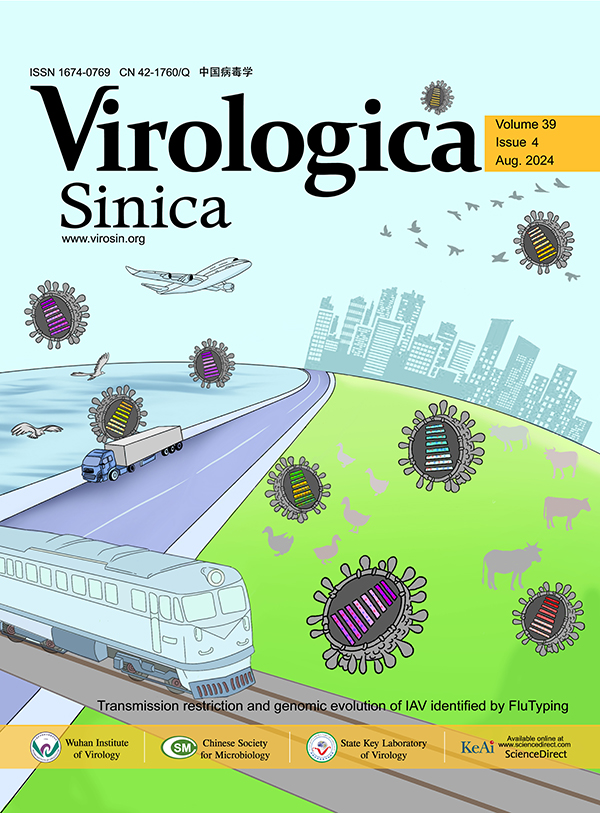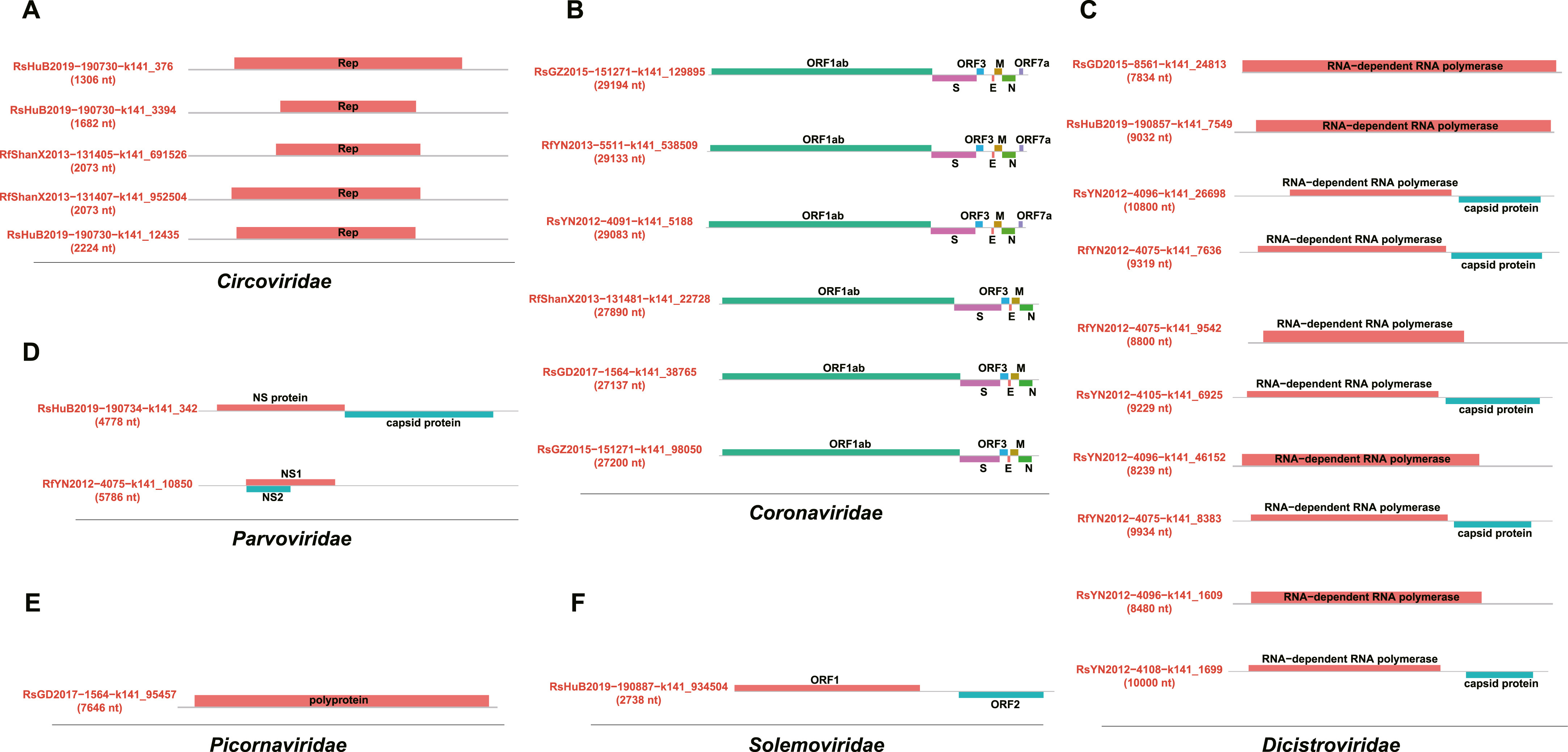-
Abu-Raddad LJ, Patnaik P, Kublin JG. 2006. Dual infection with hiv and malaria fuels the spread of both diseases in sub-saharan africa. Science, 314: 1603-1606.
-
Camacho C, Coulouris G, Avagyan V, Ma N, Papadopoulos J, Bealer K, Madden TL. 2009. Blast+: architecture and applications. BMC Bioinformatics, 10: 421.
-
Chen YM, Hu SJ, Lin XD, Tian JH, Lv JX, Wang MR, Luo XQ, Pei YY, Hu RX, Song ZG, Holmes EC, Zhang YZ. 2023. Host traits shape virome composition and virus transmission in wild small mammals. Cell, 186: 4662-4675 e4612.
-
Cui J, Li F, Shi ZL. 2019. Origin and evolution of pathogenic coronaviruses. Nat. Rev. Microbiol., 17: 181-192.
-
Danecek P, Bonfield JK, Liddle J, Marshall J, Ohan V, Pollard MO, Whitwham A, Keane T, McCarthy SA, Davies RM, Li H. 2021. Twelve years of samtools and bcftools. Gigascience, 10: giab008.
-
Falk BW, Tsai JH. 1998. Biology and molecular biology of viruses in the genus tenuivirus. Annu. Rev. Phytopathol., 36: 139-163.
-
Federici L, Masulli M, De Laurenzi V, Allocati N. 2022. An overview of bats microbiota and its implication in transmissible diseases. Front. Microbiol., 13: 1012189.
-
Fujisaka S, Watanabe Y, Tobe K. 2023. The gut microbiome: a core regulator of metabolism. J. Endocrinol., 256: e220111.
-
Gao Z, Yu L, Cao L, Yang M, Li Y, Lan Y, Tang R, Huang Y, Luan G, Liu Y, Yu H, Jian L, Zha Y, Fan Z, Bai Y, Luo M, He M, Deng S. 2023. Analysis of coexisting pathogens in nasopharyngeal swabs from covid-19. Front. Cell. Infect. Microbiol., 13: 1140548.
-
Ge XY, Li JL, Yang XL, Chmura AA, Zhu G, Epstein JH, Mazet JK, Hu B, Zhang W, Peng C, Zhang YJ, Luo CM, Tan B, Wang N, Zhu Y, Crameri G, Zhang SY, Wang LF, Daszak P, Shi ZL. 2013. Isolation and characterization of a bat sars-like coronavirus that uses the ace2 receptor. Nature, 503: 535-538.
-
Gupta RK, George R, Nguyen-Van-Tam JS. 2008. Bacterial pneumonia and pandemic influenza planning. Emerg. Infect. Dis., 14: 1187-1192.
-
Gut AM, Vasiljevic T, Yeager T, Donkor ON. 2018. Salmonella infection - prevention and treatment by antibiotics and probiotic yeasts: a review. Microbiology (Reading), 164: 1327-1344.
-
Han Y, Xu P, Wang Y, Zhao W, Zhang J, Zhang S, Wang J, Jin Q, Wu Z. 2023. Panoramic analysis of coronaviruses carried by representative bat species in Southern China to better understand the coronavirus sphere. Nat. Commun., 14: 5537.
-
He WT, Hou X, Zhao J, Sun J, He H, Si W, Wang J, Jiang Z, Yan Z, Xing G, Lu M, Suchard MA, Ji X, Gong W, He B, Li J, Lemey P, Guo D, Tu C, Holmes EC, Shi M, Su S. 2022. Virome characterization of game animals in China reveals a spectrum of emerging pathogens. Cell, 185: 1117-1129 e1118.
-
Hu B, Ge X, Wang LF, Shi Z. 2015. Bat origin of human coronaviruses. Virol. J., 12: 221.
-
Hu B, Zeng LP, Yang XL, Ge XY, Zhang W, Li B, Xie JZ, Shen XR, Zhang YZ, Wang N, Luo DS, Zheng XS, Wang MN, Daszak P, Wang LF, Cui J, Shi ZL. 2017. Discovery of a rich gene pool of bat sars-related coronaviruses provides new insights into the origin of sars coronavirus. PLoS Pathog., 13: e1006698.
-
Huang C, Liu WJ, Xu W, Jin T, Zhao Y, Song J, Shi Y, Ji W, Jia H, Zhou Y, Wen H, Zhao H, Liu H, Li H, Wang Q, Wu Y, Wang L, Liu D, Liu G, Yu H, Holmes EC, Lu L, Gao GF. 2016. A bat-derived putative cross-family recombinant coronavirus with a reovirus gene. PLoS Pathog., 12: e1005883.
-
Huang J, Jiang E, Yang D, Wei J, Zhao M, Feng J, Cao J. 2020. Metagenomic next-generation sequencing versus traditional pathogen detection in the diagnosis of peripheral pulmonary infectious lesions. Infect. Drug Resist., 13: 567-576.
-
Katoh K, Standley DM. 2013. Mafft multiple sequence alignment software version 7: improvements in performance and usability. Mol. Biol. Evol., 30: 772-780.
-
Kauffman CA. 2007. Histoplasmosis: a clinical and laboratory update. Clin. Microbiol. Rev., 20: 115-132.
-
Kechin A, Boyarskikh U, Kel A, Filipenko M. 2017. Cutprimers: a new tool for accurate cutting of primers from reads of targeted next generation sequencing. J. Comput. Biol., 24: 1138-1143.
-
Keusch GT, Amuasi JH, Anderson DE, Daszak P, Eckerle I, Field H, Koopmans M, Lam SK, Das Neves CG, Peiris M, Perlman S, Wacharapluesadee S, Yadana S, Saif L. 2022. Pandemic origins and a one health approach to preparedness and prevention: solutions based on sars-cov-2 and other rna viruses. Proc. Natl. Acad. Sci. U. S. A., 119: e2202871119.
-
Kohl C, Brinkmann A, Radonic A, Dabrowski PW, Muhldorfer K, Nitsche A, Wibbelt G, Kurth A. 2021. The virome of German bats: comparing virus discovery approaches. Sci. Rep., 11: 7430.
-
Kutikhin AG, Yuzhalin AE, Brusina EB. 2014. Mimiviridae, marseilleviridae, and virophages as emerging human pathogens causing healthcare-associated infections. GMS Hyg. Infect. Control, 9: Doc16.
-
Lau SK, Woo PC, Li KS, Huang Y, Wang M, Lam CS, Xu H, Guo R, Chan KH, Zheng BJ, Yuen KY. 2007. Complete genome sequence of bat coronavirus hku2 from Chinese horseshoe bats revealed a much smaller spike gene with a different evolutionary lineage from the rest of the genome. Virology, 367: 428-439.
-
Li D, Liu CM, Luo R, Sadakane K, Lam TW. 2015. Megahit: An ultra-fast single-node solution for large and complex metagenomics assembly via succinct de bruijn graph. Bioinformatics, 31: 1674-1676.
-
Li H, Durbin R. 2010. Fast and accurate long-read alignment with burrows-wheeler transform. Bioinformatics, 26: 589-595.
-
Loving CL, Brockmeier SL, Vincent AL, Palmer MV, Sacco RE, Nicholson TL. 2010. Influenza virus coinfection with bordetella bronchiseptica enhances bacterial colonization and host responses exacerbating pulmonary lesions. Microb. Pathog., 49: 237-245.
-
Minh BQ, Schmidt HA, Chernomor O, Schrempf D, Woodhams MD, von Haeseler A, Lanfear R. 2020. Iq-tree 2: new models and efficient methods for phylogenetic inference in the genomic era. Mol. Biol. Evol., 37: 1530-1534.
-
Olival KJ, Hosseini PR, Zambrana-Torrelio C, Ross N, Bogich TL, Daszak P. 2017. Host and viral traits predict zoonotic spillover from mammals. Nature, 546: 646-650.
-
Peck MW. 2009. Biology and genomic analysis of clostridium botulinum. Adv. Microb. Physiol., 55: 183-265, 320.
-
Rajilic-Stojanovic M, de Vos WM. 2014. The first 1000 cultured species of the human gastrointestinal microbiota. FEMS Microbiol. Rev., 38: 996-1047.
-
Ramaswamy V, Cresence VM, Rejitha JS, Lekshmi MU, Dharsana KS, Prasad SP, Vijila HM. 2007. Listeria--review of epidemiology and pathogenesis. J. Microbiol. Immunol. Infect., 40: 4-13.
-
Rizzatti G, Lopetuso LR, Gibiino G, Binda C, Gasbarrini A. 2017. Proteobacteria: a common factor in human diseases. Biomed Res. Int., 2017: 9351507.
-
Sahin E, Akata I. 2018. Viruses infecting macrofungi. Virusdisease, 29: 1-18.
-
Su, H., Wang, Y., Han, Y., Jin, Q., Yang, F., Wu, Z., 2023. Discovery and characterization of novel paramyxoviruses from bat samples in China. Virol. Sin., 38: 198-207.
-
Temmam S, Vongphayloth K, Baquero E, Munier S, Bonomi M, Regnault B, Douangboubpha B, Karami Y, Chretien D, Sanamxay D, Xayaphet V, Paphaphanh P, Lacoste V, Somlor S, Lakeomany K, Phommavanh N, Perot P, Dehan O, Amara F, Donati F, Bigot T, Nilges M, Rey FA, van der Werf S, Brey PT, Eloit M. 2022. Bat coronaviruses related to sars-cov-2 and infectious for human cells. Nature, 604: 330-336.
-
Wang J, Pan YF, Yang LF, Yang WH, Lv K, Luo CM, Wang J, Kuang GP, Wu WC, Gou QY, Xin GY, Li B, Luo HL, Chen S, Shu YL, Guo D, Gao ZH, Liang G, Li J, Chen YQ, Holmes EC, Feng Y, Shi M. 2023. Individual bat virome analysis reveals co-infection and spillover among bats and virus zoonotic potential. Nat. Commun., 14: 4079.
-
Weirich CA, Miller TR. 2014. Freshwater harmful algal blooms: toxins and children's health. Curr. Probl. Pediatr. Adolesc. Health Care, 44: 2-24.
-
Xie L, Luo G, Yang Z, Wu WC, Chen J, Ren Y, Zeng Z, Ye G, Pan Y, Zhao WJ, Chen YQ, Hou W, Sun Y, Guo D, Yang Z, Li J, Holmes EC, Li Y, Chen L, Shi M. 2024. The clinical outcome of covid-19 is strongly associated with microbiome dynamics in the upper respiratory tract. J. Infect., 88: 106118.
-
Yu G, Lam TT, Zhu H, Guan Y. 2018. Two methods for mapping and visualizing associated data on phylogeny using ggtree. Mol. Biol. Evol., 35: 3041-3043.
-
Yu XJ, Liang MF, Zhang SY, Liu Y, Li JD, Sun YL, Zhang L, Zhang QF, Popov VL, Li C, Qu J, Li Q, Zhang YP, Hai R, Wu W, Wang Q, Zhan FX, Wang XJ, Kan B, Wang SW, Wan KL, Jing HQ, Lu JX, Yin WW, Zhou H, Guan XH, Liu JF, Bi ZQ, Liu GH, Ren J, Wang H, Zhao Z, Song JD, He JR, Wan T, Zhang JS, Fu XP, Sun LN, Dong XP, Feng ZJ, Yang WZ, Hong T, Zhang Y, Walker DH, Wang Y, Li DX. 2011. Fever with thrombocytopenia associated with a novel bunyavirus in China. N. Engl. J. Med., 364: 1523-1532.
-
Zhou P, Yang XL, Wang XG, Hu B, Zhang L, Zhang W, Si HR, Zhu Y, Li B, Huang CL, Chen HD, Chen J, Luo Y, Guo H, Jiang RD, Liu MQ, Chen Y, Shen XR, Wang X, Zheng XS, Zhao K, Chen QJ, Deng F, Liu LL, Yan B, Zhan FX, Wang YY, Xiao GF, Shi ZL. 2020. A pneumonia outbreak associated with a new coronavirus of probable bat origin. Nature, 579: 270-273.
-
Zhu W, Huang Y, Gong J, Dong L, Yu X, Chen H, Li D, Zhou L, Yang J, Lu S. 2023. A novel bat coronavirus with a polybasic furin-like cleavage site. Virol. Sin., 38: 344-350.














 DownLoad:
DownLoad: